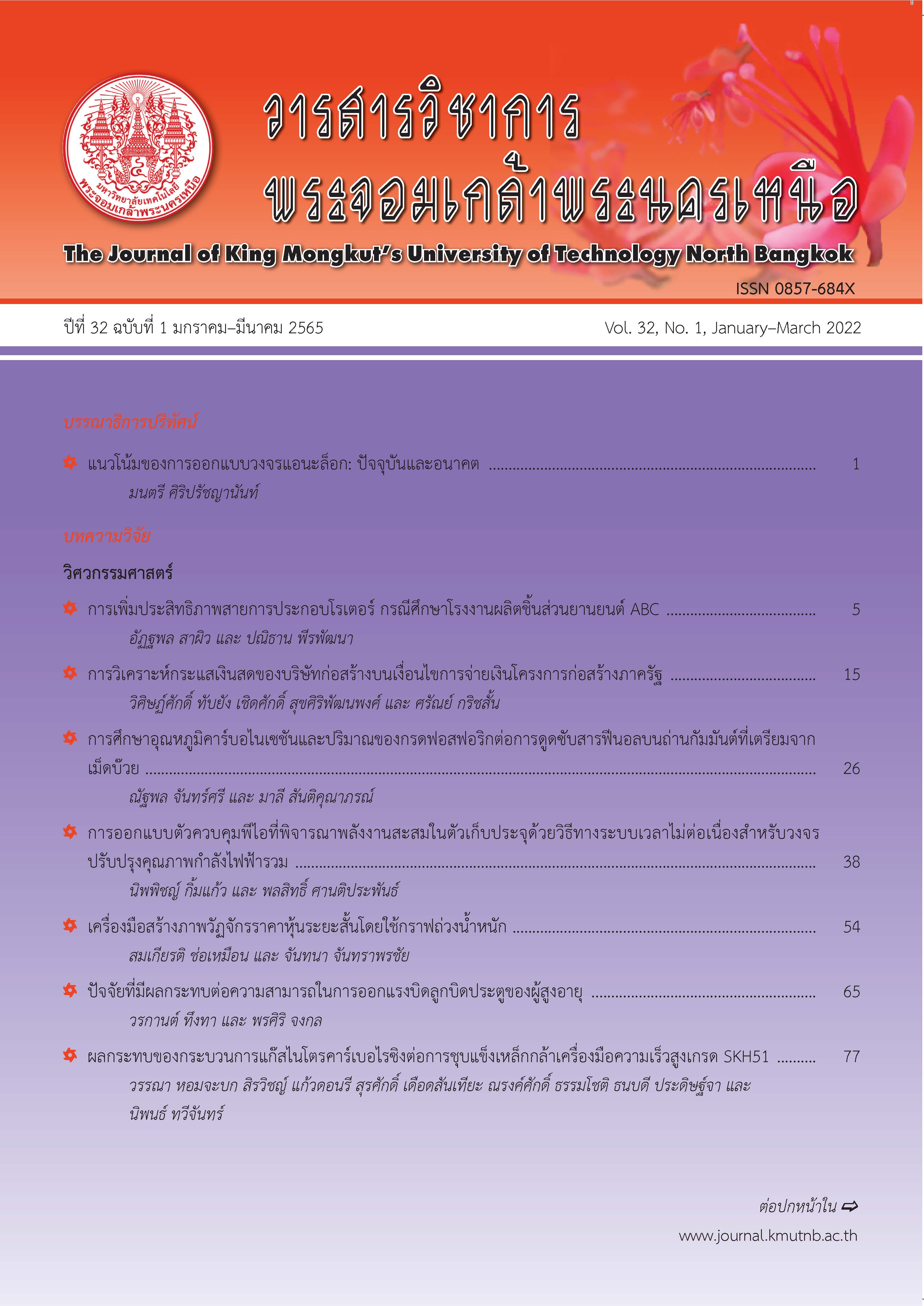ผลกระทบของมวลรวมคอนกรีตรีไซเคิลจากโรงงานคอนกรีตผสมเสร็จต่อความต้านทานการแทรกซึมคลอไรด์และกำลังอัดของคอนกรีต
Main Article Content
บทคัดย่อ
บทความนี้มุ่งศึกษาผลกระทบของมวลรวมคอนกรีตรีไซเคิลจากโรงงานคอนกรีตผสมเสร็จต่อความต้านทานการแทรกซึมคลอไรด์และกำลังอัดของคอนกรีต โดยมวลรวมคอนกรีตรีไซเคิลถูกใช้เป็นวัสดุแทนที่มวลรวมหยาบธรรมชาติที่การแทนที่ร้อยละ 10, 25, 50 และ 100 ใช้อัตราส่วนน้ำต่อวัสดุประสานที่ 0.40 และอัตราส่วนเถ้าลอยต่อวัสดุประสานที่ 0.30 การทดสอบการแทรกซึมคลอไรด์แบบเร่งและทดสอบกำลังอัดของคอนกรีตทำการทดสอบที่ระยะเวลาบ่มน้ำ 28, 56 และ 91 วัน สำหรับการทดสอบการแทรกซึมคลอไรด์แบบแพร่ทั้งหมดของคอนกรีตทำการทดสอบที่ระยะเวลาบ่มน้ำ 28 วัน จากนั้นคอนกรีตถูกนำไปเผชิญสารละลายคลอไรด์ที่ความเข้มข้น 3.0% เป็นเวลา 28, 56 และ 91 วัน จากผลการทดลองพบว่า เมื่ออัตราส่วนมวลรวมคอนกรีตรีไซเคิลต่อมวลรวมหยาบสูงขึ้นทำให้ความต้านทานการแทรกซึมคลอไรด์และกำลังอัดของคอนกรีตต่ำลง คอนกรีตผสมเถ้าลอยที่ใช้มวลรวมคอนกรีตรีไซเคิลมีความต้านการแทรกซึมคลอไรด์สูงกว่าคอนกรีตซีเมนต์ล้วนที่ใช้มวลรวมคอนกรีตรีไซเคิลและมีกำลังอัดเกือบใกล้เคียงคอนกรีตซีเมนต์ล้วนที่ใช้มวลรวมรีไซเคิลที่อายุ 91 วัน
Article Details
บทความที่ลงตีพิมพ์เป็นข้อคิดเห็นของผู้เขียนเท่านั้น
ผู้เขียนจะต้องเป็นผู้รับผิดชอบต่อผลทางกฎหมายใดๆ ที่อาจเกิดขึ้นจากบทความนั้น
เอกสารอ้างอิง
[2] S. Tangtermsirikul, Durability and Mix Design of Concrete, 1st ed. Pathum Thani: Thammasat University, Rangsit Campus, 2003.
[3] P. Chindaprasirt, S. Rukzon, and V. Sirivivatnanon, “Resistance to chloride penetration of blended portland cement mortar containing palm oil fuel, rice husk ash and fly ash,”Construction and Building Materials, vol. 22, pp. 932–938, 2008.
[4] P. Chindaprasirt and C.Jaturapitakkul, Cement, Pozzolan and Concrete. Bangkok: Thai Concrete Assocoation (TCA), 2004 (in Thai).
[5] K. Y. Ann, H. Y. Moon, Y. B. Kim, and J. Ryou, “Durability of recycled aggregate concrete using pozzolanic materials,” Waste Management, vol. 28, pp. 993–999, 2008.
[6] M. B.de Oliveira and E.Vazquez, “The influence of retained moisture in aggregates from recycling on the properties of new hardened concrete,” Waste Management, vol. 16, pp. 113–117, 1996.
[7] C. S. Poon, Z. H. Shui, and L. Lam, “Effect of microstructure of ITZ on compressive strength of concrete prepared with recycled aggregates,” Construction and Building Materials, vol. 18, pp. 461–468, 2004.
[8] D. Sani, G. Moriconi, G. Fava, and V. Corinaldesi, “Leaching and mechanical behaviour of concrete manufactured with recycled aggregated,” Waste Management, vol. 25, pp. 117–182, 2005.
[9] T. Y. Tu, Y. Y. Chen, and C. L. Hwang, “Properties of HPC with recycled aggregates,” Cement and Concrete Research, vol. 36, pp. 943–950, 2006.
[10] S. C. Kou and C. S. Poon, “Enhancing the durability properties of concrete prepared with coarse recycled aggregate,” Construction and Building Materials, vol. 35, pp. 59–76, 2012.
[11] Standard Test Method for Electrical Indication of Concrete's Ability to Resist Chloride Ion Penetration, American Society for Testing and Materials, ASTM C1202, 2000.
[12] Standard Test Method for Determining the Apparent Chloride Diffusion Coefficient of Cementitious Mixtures by Bulk Diffusion, American Society for Testing and Materials, ASTM C1556, 2000.
[13] Standard Test Method for Acid-Soluble Chloride in Mortar and Concrete, American Society for Testing and Materials, ASTM C1152, 2000.
[14] Method for determination of compressive strength of concrete cubes, British Standards (BS), BS 1881-116.
[15] B. H. Oh, S. W. Cha, B. S. Jang, and S. Y. Jang, “Development of high-performance concrete having high resistance to chloride penetration,” Nuclear Engineering and Design, vol. 212, pp. 221–231, 2002.
[16] P. Yue, Z. Tan, and Z. Guo, “Microstructure and mechanical properties of recycled aggregate concrete in seawater environment,” The Scientific World Journal, vol. 2013, pp. 1–7, 2013.
[17] S. E. Hussain and S. Rasheeduzafar, “Corrosion resistance performance of fly ash blended cement concrete,” ACI Material Journal, vol. 91, pp. 264–273, 2013.
[18] T. Simcic, S. Pejovnik, GDe. Schutter, and V. B. Bosiljkov, “Chloride ion penetration into fly ash modified concrete during wetting-drying cycles,” Construction and Building Materials, vol. 93, pp. 1216–1223, 2015.
[19] A. M. Wagih, H. Z. EI-Karmoty, M. Ebid, and S. H. Okba, “Recycled construction and demolition concrete waste as aggregate for structural concrete,” Housing and Building National Research Center Journal, vol. 9, pp. 193–200, 2013.
[20] H. Dilbas, M. Simsek, and O. Cakie, “An investigation on mechanical and physical peoperties of recycled aggregate concrete (RAC) with and without silica fume,” Construction and Building Materials, vol. 61, pp. 50–59, 2014.
[21] A.M. Neville, Properties of Concrete, 4th ed. Longman Group Ltd., 1995.

